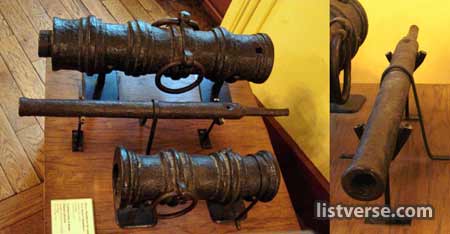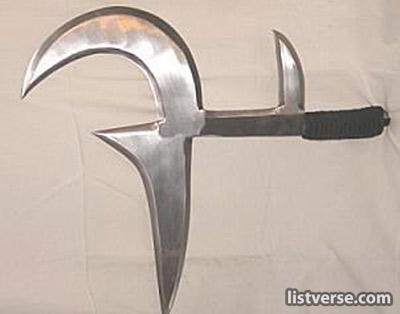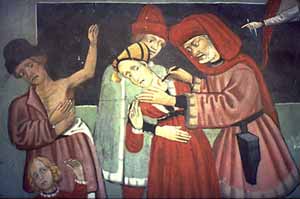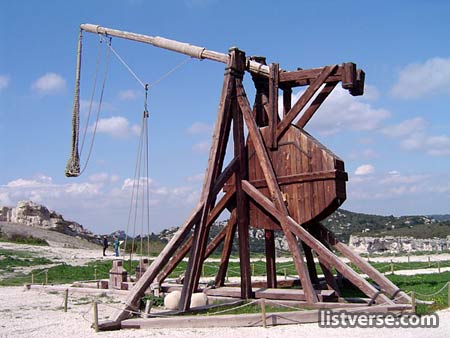 Music
Music  Music
Music  History
History 10 Less Than Jolly Events That Occurred on December 25
 Weird Stuff
Weird Stuff 10 Funny Ways That Researchers Overthink Christmas
 Politics
Politics 10 Political Scandals That Sent Crowds Into the Streets
 Weird Stuff
Weird Stuff Ten Bizarre Facts About The Doge Meme
 Our World
Our World 10 Ways Your Christmas Tree Is More Lit Than You Think
 Movies and TV
Movies and TV The 10 Coolest Stars to Set Sail on The Love Boat
 History
History 10 Things You Didn’t Know About the American National Anthem
 Technology
Technology Top 10 Everyday Tech Buzzwords That Hide a Darker Past
 Humans
Humans 10 Everyday Human Behaviors That Are Actually Survival Instincts
 Music
Music 10 Surprising Origin Stories of Your Favorite Holiday Songs
 History
History 10 Less Than Jolly Events That Occurred on December 25
 Weird Stuff
Weird Stuff 10 Funny Ways That Researchers Overthink Christmas
Who's Behind Listverse?

Jamie Frater
Head Editor
Jamie founded Listverse due to an insatiable desire to share fascinating, obscure, and bizarre facts. He has been a guest speaker on numerous national radio and television stations and is a five time published author.
More About Us Politics
Politics 10 Political Scandals That Sent Crowds Into the Streets
 Weird Stuff
Weird Stuff Ten Bizarre Facts About The Doge Meme
 Our World
Our World 10 Ways Your Christmas Tree Is More Lit Than You Think
 Movies and TV
Movies and TV The 10 Coolest Stars to Set Sail on The Love Boat
 History
History 10 Things You Didn’t Know About the American National Anthem
 Technology
Technology Top 10 Everyday Tech Buzzwords That Hide a Darker Past
 Humans
Humans 10 Everyday Human Behaviors That Are Actually Survival Instincts
Top 10 Badass Ancient Weapons
Long before drive by shootings and police stabbings, our ancestors used some truly badass weapons against each other. Our ancient ancestors seemed to have a knack for finding the most gruesome and painful ways to attack each other – you could even argue that no modern weapons come close to being able to inflict the same level of suffering as these ancient weapons. You might even be forgiven for being thankful for guns with their quick deaths when you read this list of top 10 badass weapons.
This is a list of the most badass weapons in ancient history. This list excludes weapons beyond the medieval period.


Culverins were medieval guns. These were often used by horsemen in a medieval kind of drive-by shooting. The hand culverin were made of a simple smoothbore tube, closed at one end except for a small hole designed to fire the gunpowder. The tube was held in place by a wooden piece which could be held under the arm. The tube was loaded with gunpowder and lead bullets. The culverin was fired by inserting a lighted cord into the hole. In the image above, the hand culverin is between two small canons.
These hand culverins soon evolved into heavier portable culverins, around 40kg in weight, which required a swivel for support and aiming. Such culverins were further equiped with back-loading sabots to facilitate reloading, and were often used on ships – a precursor to the modern canon.

A caltrop is a weapon made up of two (or more) sharp nails or spines arranged so that one of them always points upward from a stable base (for example, a tetrahedron). Caltrops serve to slow down the advance of horses, war elephants, and human troops. It was said to be particularly effective against the soft feet of camels.

In modern times Caltrops have been used at times during labor strikes and other disputes. Such devices were used by some to destroy the tires of management and replacement workers. Because of the prevalence of caltrops during the Caterpillar strike of the mid-1990s, the state of Illinois passed a law making the possession of such devices a misdemeanor.
Iron caltrops were used as early as 331 BC at Gaugamela according to Quintus Curtius. They were known to the Romans as tribulus or sometimes as Murex ferreus, meaning ‘jagged iron’. The Roman writer Vegetius said:
The Roman soldiers rendered [the armed chariots] useless chiefly by the following contrivance: at the instant the engagement began, they strewed the field of battle with caltrops, and the horses that drew the chariots, running full speed on them, were infallibly destroyed. A caltrop is a device composed of four spikes or points arranged so that in whatever manner it is thrown on the ground, it rests on three and presents the fourth upright.
Punji sticks and caltrops were used in the Vietnam War, sometimes with poison or manure on the points.

Back in the day, you had to scale the walls of a city or castle before you could rape and pillage. This led someone to the brilliant idea that you could pour boiling oil on top of the people trying to climb in.

Oil was not difficult to come by as the women would all donate their cooking oil (a small price to pay to keep their privates private). If the town ran out of oil, they would use boiling water, or other easily obtainable things like sand.
Castles were often built with special holes in the sides to make it easier to pour this blistering liquid on unsuspecting climbers. They were so effective that they were called murder-holes. These holes were also useful for firing arrows at attackers or throwing rocks. Similar holes, called machicolations, were often located in the curtain walls of castles and city walls. The parapet would project over corbels so that holes would be located over the exterior face of the wall, and arrows could be shot at, rocks dropped on, or boiling water poured over, any attackers near the wall.
Various sources claim that molten lead was also used as a weapon in this way, but there is no historical evidence to support that view.

We all know that crossbows are badass – but what about the arbalest? The Arbalest was a larger version of the crossbow and it had a steel prod (“bow”). Since an arbalest was much larger than earlier crossbows, and because of the greater tensile strength of steel, it had a greater force. The strongest windlass-pulled arbalests could have up to 22 kN (5000 lbf) strength and be accurate up to 500m. A skilled arbalestier (arblaster) could shoot two bolts per minute. Arbalests were sometimes considered inhumane or unfair weapons, since an inexperienced crossbowman could use one to kill a knight who had a lifetime of training.

The use of crossbows in European warfare dates back to Roman times and is again evident from the battle of Hastings until about 1500 AD. They almost completely superseded hand bows in many European armies in the twelfth century for a number of reasons. Although a longbow had greater range, could achieve comparable accuracy and faster shooting rate than an average crossbow, crossbows could release more kinetic energy and be used effectively after a week of training, while a comparable single-shot skill with a longbow could take years of practice. Crossbows were eventually replaced in warfare by gunpowder weapons, although early guns had slower rates of fire and much worse accuracy than contemporary crossbows.
This weapon was so badass, that Pope Innocent II (pictured to the left) banned them at the second Lateran Council in 1139:
We prohibit under anathema that murderous art of crossbowmen and archers, which is hateful to God, to be employed against Christians and Catholics from now on.
Today the crossbow often has a complicated legal status due to the possibility of lethal use and its similarities with both firearms.

The Hunga Munga is an iron fighting tool named by the African tribes south of Lake Tchad; also called “danisco” by the Marghi, “goleyo” by the Musgu, and “njiga” by the Bagirmi. It is handheld weapon and has a metal pointed blade with a curved back section and separate spike near the handle. The weapon can be used in hand to hand combat (Melee) although it is normally thrown with a spinning action.

These African iron weapons are thrown with a rotatory motion (similar to an Australian boomerang), and cause deep wounds with their projecting blades. They come in many shapes and sizes and they were (and are) used across Africa from the Upper Nile on the east through Central Africa by Lake Tchad to the Africans of the Gaboon in West Africa. In parts of Central Africa, these weapons are shaped like a bird’s head.
This weapon is used in the Role-Playing game Mage The Ascension by the Euthanatos characters for their magical rituals. Buffy (from Buffy the Vampire Slayer – image to the right) used one of these from time to time to battle demons that enslave their victims and force them to give up their identities. The hunga munga was used in the opening credits of the show.

The Morning Star (also sometimes called the goedendag or Holy Water sprinkler) is a term used for a variety of club-like weapons with one or more sharp spikes sticking out of it. It would normally have one big spike poking out of the top with a bunch of smaller ones around the sides. These are often thought of as peasant weapons, but there were also very high quality ones made for the rich guys.

These weapons were most effective when you hit someone on the head with them. The Holy Water sprinkler, was a morning star popular with the English army from the sixteenth century and made in series by professional smiths. Some of them were over 6 foot long! This was the favored weapon of King John of Bohemia who was blind – he would just sit on his horse and swing the thing until he hit someone (preferably one of the bad guys).
In the game Mortal Kombat Deception, the character Havik (in the picture to the right) weilds a morning star in his form of armed combat. The Morning Star is considered to be a Holy Weapon in Dungeons and Dragons. Of course, when not engaged in battle, this was a useful tool for keeping thine wyfe and kids in line, or as a backscratcher. Badass!

One of the upsides to siege warfare in the middle ages was the huge number of dead bodies from people who had died of plague or other mysterious illnesses. A very handy use for these bodies was biological warfare! Most towns would barricade themselves behind huge walls that could not be breached by the enemy – but they often relied on outside sources of fresh water. This is where the bodies come in. You could dump a few bodies in the rivers leading in to the town and all you had to do was wait! A perfect opportunity to sit back and watch some jousting.

After a while, the plague would infect the town and you have a great victory! Obviously you can’t rape and pillage too soon, but at least you didn’t lose any men (except maybe the poor guys that had to carry the bodies to the river). In the image to the left, we see Jane Godbotherer being treated for the plague. She will eventually end up being used as a biological weapon.
Plague infection in a human occurs when a person is bitten by a flea that has been infected by biting a rodent that itself has been infected by the bite of a flea carrying the disease.
This type of warfare was used before the advent of catapults which were more much more effective at infecting towns with disease.

With the advent of the trebuchet (a very high powered catapult) came the realization that plagued bodies were no longer needed to slowly kill people in a fortified town or castle – you could simply catapult a rotting or diseased animal over the ramparts – or for truly fast results, you could fling over a few beehives. Dead horses were a popular weapon in this form of biological warfare, though anything filled with disease would do the trick.
The counterweight trebuchet appeared in both Christian and Muslim lands around the Mediterranean in the twelfth century. It could fling three-hundred-pound (140 kg) projectiles at high speeds into enemy fortifications. Trebuchets were invented in China in about the 4th century BC, came to Europe in the 6th century AD, and did not become obsolete until the 16th century, well after the introduction of gunpowder. Trebuchets were far more accurate than other medieval catapults.
The trebuchet could launch projectiles a distance of over half a mile (over 750 m).

Picture, if you will, a slow day on the seas. The water is calm, the sky is blue, when suddenly, from out of nowhere, it starts raining fire! You discover that you have just been engaged by a Greek warship and they have flame-throwers! Yes – that’s right, the Greeks used flame-throwers in their naval battles from around 670 AD. So what do you do when you are being fired on by flame-throwers? According to one witness:
“Every time they hurl the fire at us, we go down on our elbows and knees, and beseech Our Lord to save us from this danger.”

In other words, not much! The recipe for Greek fire was a closely guarded secret – even now no one really knows what it was made of. Modern scientists have ventured a few guesses: petroleum, niter, sulfur; or naphtha, quicklime, sulfur; or phosphorus and saltpeter. Regardless of the recipe, the stuff was heated in a cauldron on the ship and squirted out a giant syringe at the enemy.
But… the Chinese beat them to it
In the 3rd century BC, a flammable liquid substance was found in the Gao Nu County, located in the northeast portion of what is now the Shaanxi Province. This “flammable liquid” (called Meng Huo You) was probably petroleum that had seeped through the ground and was floating above the local waters. Ever the ingenious people, the Chinese put it to good use in destroying towns built with timber.
In 900 AD, the Chinese also invented the Pen Huo Qi – a piston based naphtha flamethrower. The double-piston pump flamethrower was carefully documented and illustrated in the Chinese military manual known as the Wujing Zongyao (image on the right). It was, of course, used in siege warfare.

I am sure most will agree that it doesn’t get more badass than this. A scythed chariot was a war chariot with one or more blades mounted on both ends of the axle. The scythed chariot was pulled by a team of four horses and manned by a crew of up to three men, one driver and two warriors. Theoretically the scythed chariot would plow through infantry lines, cutting combatants in half or at least opening gaps in the line which could be exploited. It was difficult to get horses to charge into the tight phalanx formation of the Greek/Macedonian hoplites (infantry). The scythed chariot avoided this inherent problem for cavalry, by the scythe cutting into the formation, even when the horses avoided the men.
The blades extended horizontally for a meter on the sides of the chariot. Xenophon, an eyewitness, describing the scythed chariots at the battle of Cunaxa says, “These had thin scythes extending at an angle from the axle and also under the driver’s seat, turned towards the ground”.
A scythed chariot can be seen in the chariot race of the movie Ben Hur, operated by Messala (here called a “Greek chariot” or a “beaked chariot.”). Scythed chariots are seen in the first Colosseum scene in the movie Gladiator. In the film Alexander by Oliver Stone, scythed chariots are shown charging into Macedonian phalanx during the beginning of Battle of Gaugamela scene.
This article is licensed under the GFDL because it contains quotations from the Wikipedia articles: Crossbow, Caltrop, Trebuchet, Scythed Chariot








